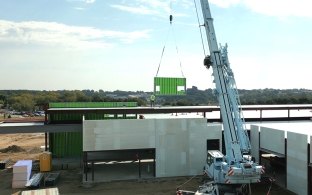Design-Build Novation – It’s Time for Some Rebranding
The design-build novation model is a project delivery method where a design team and construction contractor are connected through a client and form a contractual working partnership. Progressive clients, designers and contractors view this method as an opportunity to advance the design-build method with a collaborative mindset.


What Is Novation?
Novation in a contract replaces the responsibilities of an individual or business with a new party. Novation supersedes the original contract and transfers rights and obligations to the new party. Every party agrees on the contract and there are no hostile negotiations or takeovers.
What Does Novation Mean in Construction?
Novation in construction contracts often refers to the design consultants contracted by the client being “novated” to work with the contractor. This allows the design team and the contractor to collaborate for design-build project delivery. The project owner or client arranges for the contractors from the building company and the design teams from a design firm to work directly together as design-build partners for the duration of the project. In traditional design-build construction, the design-build delivery is performed by a single company.

The Design-Build Novation Model in Action
The design-build novation model can be an effective way for teams to directly collaborate and utilize each other's strengths. The University of California Riverside (UC-Riverside) project team, a highly experienced team in collaborative project delivery, used the design-build novation model for their North District Phase 2 Student Housing Development.
UC-Riverside utilized three phases to make the novation model a success:
- Phase 1: Design
- UC-Riverside worked with a trusted design partner, SCB Architects, to advance the project through schematic design. They developed preliminary drawings and models to establish the project’s overall layout and design.
- Phase 2: Development
- The UC-Riverside team then procured the design-build team at McCarthy Building Companies, Inc. The combined team of McCarthy and SCB collaborated “pre-novation” under separate contracts to advance the design to development.
- Phase 3: New Contracts
- Contract novation between McCarthy and SCB occurred when the project owner from UC-Riverside had confidence that the housing design met their cost and design requirements. This allowed McCarthy and SCB to work directly with one another to complete the project.
The Advantages and Disadvantages of Design-Build Novation for Clients and Project Owners
Design-build novation can be a beneficial method that offers clients a collaborative project delivery process and agency to choose individual partnerships. However, it’s not always the best option, as some agencies prefer to avoid novation contracts, and it can take time to understand which project teams will work well under this model.
The Advantages of Design-Build Novation
The criteria architect can also be the designer on the design-build team.
During the planning stage of a design-build project, clients often procure a criteria architect to establish project requirements and standards. Historically, the criteria architect provides limited continued assistance to the client and is precluded from participating as a member of the design-build team once the project begins. This can be a major loss, as the criteria architect has invested hours engaging with project stakeholders, understanding the client’s conditions of satisfaction and developing a conceptual design. With design-build novation, the client’s criteria architect can remain on the project instead of the contractor bidding with their designers for concepts that fit the criteria architect’s standards.
The client can select designers and contractors separately.
If clients have a history of working with a trusted architect and/or contractor, design-build novation allows them to offer contracts to each party while still benefiting from the collaborative design-build delivery method.
Variations can occur with criteria document development and contractor procurement methods.
As design and construction industry professionals advance, the need for flexibility among project teams increases. Novated design and build combines the benefits of a design team that’s been engaged from the start of a project with the ability to find a contractor that meets the specific project’s needs. Together, these teams can then refine the criteria document. This results in a fully integrated design-build partnership that can ensure project success.
The Disadvantages of Design-Build Novation
Disadvantages exist with every project delivery method, and design-build novation won’t work for every owner.
This method doesn’t always work well for novice design-build clients.
It takes experience to understand how to manage the novation of separate, unfamiliar contractor and design teams and to achieve a mutual culture of respect and teamwork for their partnership to be successful.
The method requires modification of contract documents to address the novation.
Modification of contract documents means legal experts must be brought in to finalize the novation. This can add time and cost to a project.
Novation may not be compliant in all states and with all agencies.
Make sure any team you want to work with is in an area where the novation agreement is legal.
3 Tips for Successful Design-Build Novation
- Work with teams experienced in collaborative project delivery methods. It’s beneficial for the architect, contractor and owner to have experience with collaboration to create a positive work environment.
- Establish clear communication. A thorough and clear communication matrix through the phases of design, development and documentation helps align all teams in their understanding of each project phase.
- Keep your design-build team involved throughout the project. Include the design-build team in the design development and construction document phases. This helps to establish trust among all teams
Work With a Team That Excels in Novation
There’s a history of poorly executed examples of two parties forced into a partnership on a project. However, McCarthy is a case for the benefits of design-build novation. Our teams are eager to work with others and create projects that stand the test of time.
McCarthy is a proud member of the Design-Build Institute of America (DBIA), an institute with a mission to redefine project delivery through education and collaboration.
To learn more about working with McCarthy and our quality processes, contact us today.
Jason Dunster, P.E., is an Integrated Design Director at McCarthy Building Companies, Inc. in Newport Beach, Calif. He has more than two decades of experience as a designer, owner advisor, and contractor, much of that time spent as a design-build practitioner. Jason is an active regional and national participant in DBIA, a lifelong student of project delivery models, and a licensed civil engineer in California.








